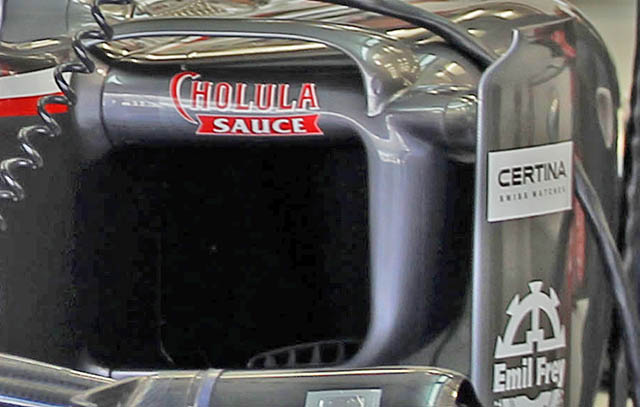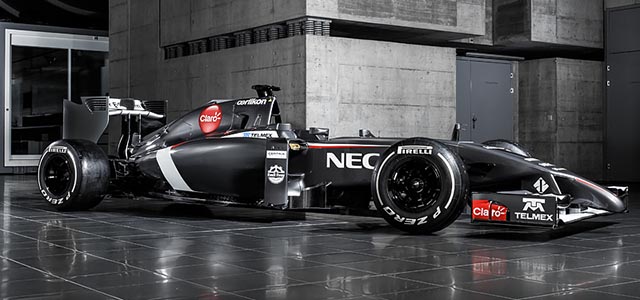

Chassis: Sauber Class: F1 2014 Engine: Ferrari 059/3 1.6L Turbo V6 Fuel: Petrol Transmission:8 speed sequential Brakes: Carbon/Carbon 0 Weight: – Fuel Tank: ATL Year introduced: 2014
The changes to the regulations introduced for 2014 are arguably the most sweeping ever seen in Formula One. As far as the engine in particular is concerned, the changes require a completely new concept. In place of last season’s naturally aspirated 2.4-litre V8 engine comes a 1.6-litre turbocharged V6 power unit, backed up by an energy recovery system (ERS) which is twice as powerful as in the past and with, potentially, more than ten times the deployable energy.
But that’s not all; key changes have also been introduced on the aerodynamics. For example, the maximum width of the front wing is now 165 cm (previously 180 cm) and the nose will be very low. This is intended to improve safety. Lower noses have been introduced by agreement between the FIA and the teams to reduce the risk that a car will be launched into the air in the case of a nose to rear wheel accident and also to reduce the risk of a driver injury in the event of a “T bone” accident.
Modifications have also been made to the dimensions of the chassis profile at the front of the car and the side crash elements, which are now standardised. The side impact test has been replaced by push off and load tests which are more stringent than before. These structures, combined with the way they are attached to the chassis, should result in better safety in the case of an oblique side impact. In addition, the lower rear wing is now removed. The aerodynamic effects, which could previously be achieved at the rear of the car through the manipulation of exhaust gases, are now restricted, with the position of the exhaust now more precisely defined. Side exhaust exits are no longer permitted; the exhaust tailpipe will now exit centrally and rearwards, with only minor changes allowed to its angle.
All of these measures reduce downforce and, therefore, decrease cornering speed. The cars will also be slower due to the raising of the minimum weight, which increases from 642 kg (including driver) to 690 kg, cancelling out – at least in part – the weight added by the new technical systems.
As Eric Gandelin, Sauber F1 Team Chief Designer, explained: “Together, these changes present the engineers with a huge challenge, especially with time pressure also a major factor. We’ve had to make various decisions on the chassis before all the necessary data and information was available to us. That is understandable, given that engine development continues alongside that of the rest of the car up to the last possible moment. And ultimately, of course, that is in our interests as well.”
The engineers, therefore, followed the path offering the greatest possible flexibility, which allows them to respond to unexpected factors or developments.
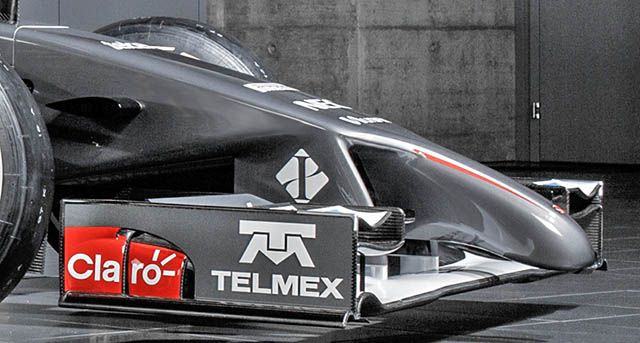
Perhaps the most visually striking element of the Sauber C33-Ferrari is the very low, snout-like nose. The front wing pylon’s attachments on the nose have been moved out as far as possible allowed by the regulations to channel as much air as possible under the car.
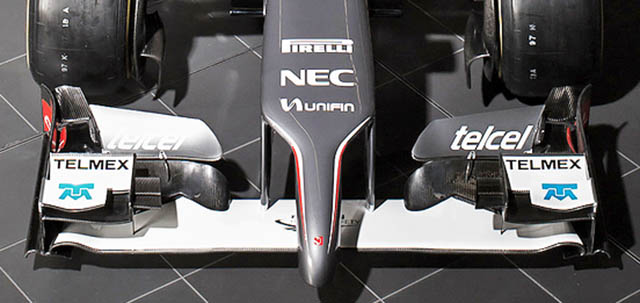
The aerodynamics engineers were handed a new brief for the design of the front wing, which is 7.5 centimetres narrower on either side than the previous version. This creates very different airflow conditions. The entire front wing with its complex end plates, has, therefore, been newly developed from the ground up.
The front suspension concept has changed little, with its springs and dampers again pushrod-actuated. However, the changes to the regulations regarding the chassis profile have called for some detail adjustments.
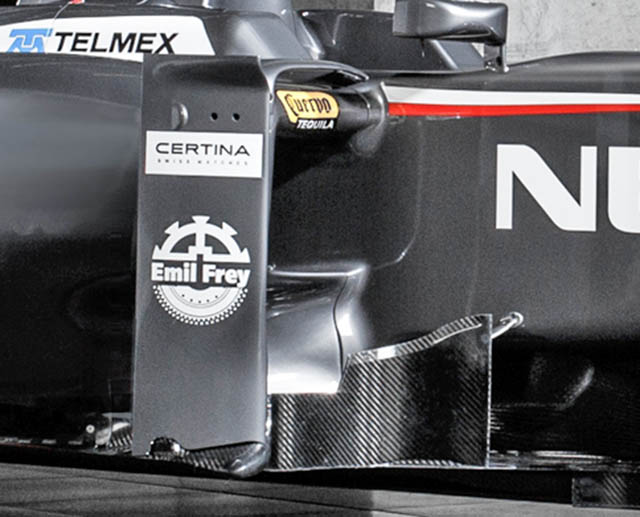
The side crash elements have had a significant influence on the form of the side pods which is clearly visible in the design of the car. The cooling air intakes are slightly larger than those of last year’s car because the cooling requirements of the power unit and ancillaries have increased considerably. For the same reason, the vertically mounted radiators are now significantly larger. Again, the engineers have built a degree of flexibility into their design to allow scope to react should requirements shift in one or other direction.
Note the turning vane around the side pod inlet, as with the C32 the top element splits in two. It has been speculated that this will contain a cooling duct.
Complex power unit
The car’s engine, energy recovery system and gearbox are supplied by Ferrari. The 1.6-litre turbocharged V6 engine has a rev limit of 15,000 rpm. A maximum 100 kg of fuel can be used for each race. Previously there was no limit on fuel usage and up to 140 kg of fuel was used, so this represents a significant improvement in fuel efficiency. Continuing the environmental theme, this year the number of engines which can be used in a season is also reduced from eight to five.
Where previously a maximum KERS boost of 60 kW was available for 6.6 seconds, now the drivers will be able to call on an extra 120 kW of power for 33 seconds per lap from the batteries. This additional output is fuelled not only by the kinetic energy generated under braking, but also by the heat energy produced by the engine. The system now comprises two electric motors/generators, one coupled to the V6 engine’s drive unit, the other connected to the turbocharger’s exhaust gas turbine. It is also possible to drive the electric motor attached to the engine directly from the one driven by the turbocharger, which can extend the total usable electrical energy further. The turbocharger can also be driven electronically to limit delays in the creation of engine power on first application of throttle.
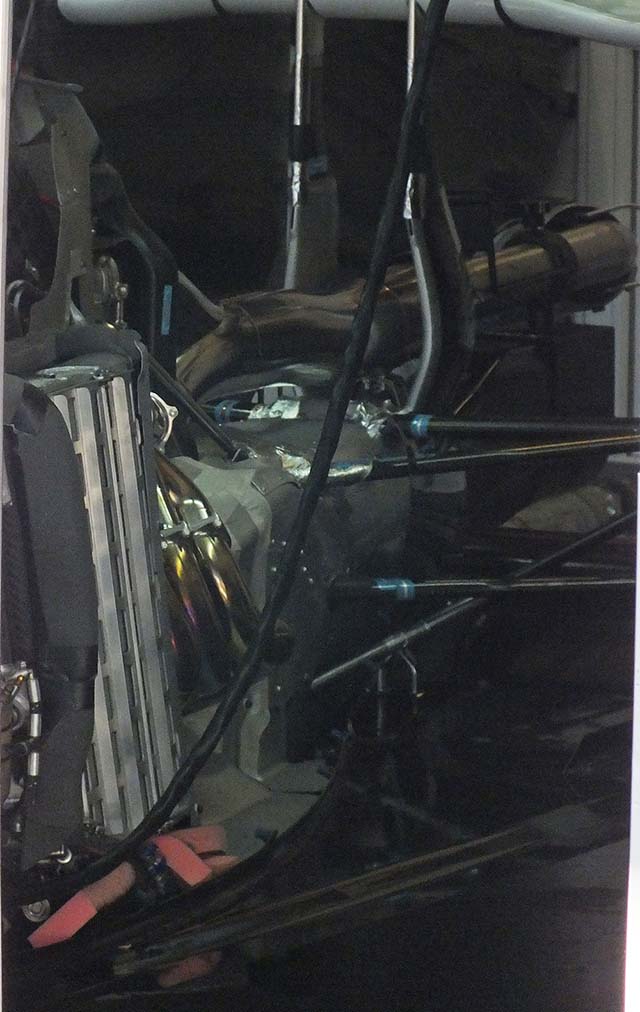
Suaber’s official press kit says that the all-new carbon gearbox has eight forward gears (as stipulated in the regulations), whose ratios may only be changed once over the course of the 2014 season. But the image above taken of the transmission on the car at Jerez shows that the ‘box is fully encased in a heat shield. Note the exhaust shape and position as well as the rear wing picking up on the transmission casing.
The whole power unit may not weigh less than 145 kg.
Flexibility and Adaptability
The concept for the rear of the Sauber C33-Ferrari also includes a degree of adaptability, so that the engineers can make adjustments to this area of the car in response to varying conditions. The exhaust tailpipe is positioned centrally between two pylons, which connect the rear wing to the rear impact structure. A change in the regulations has enlarged the maximum permitted aperture between the flap and the main wing to 65 mm (during DRS activation – previously 50 mm), which increases the DRS effect of the rear wing.
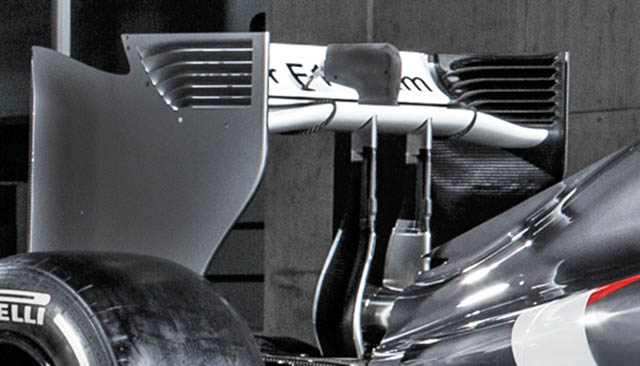
Looking at the rear wing of the C33 reveals that the wing support is very similar in concept to that of the Ferrari F14-T, both designs share common parts so this is not a surprise, note the heat shielding on the inside of the support, and the small bee sing on the trailing edge of the bodywork.
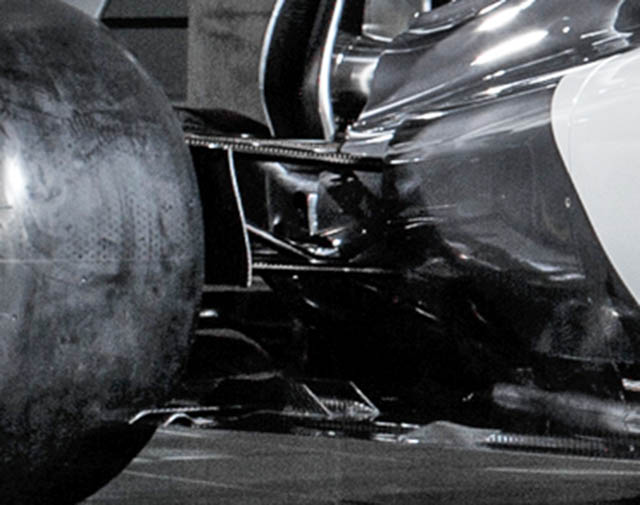
The concept of the rear suspension remains unchanged. As previously, it is pull-rod-actuated. Note the small floor strakes just visible above and below, something not seen so far on other designs. The size of the hole to allow rear wishbone movement is larger than it needs to be this is as it can be used to aid cooling
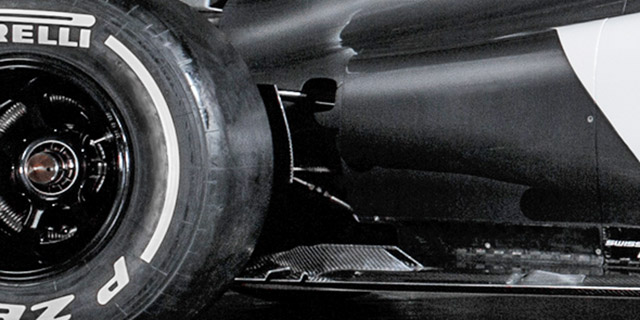
The weight of the car presents the engineers with a major challenge, as the 48 kg higher minimum weight only partly cancels out the weight added predominantly by the power unit and its ancillaries. But not only the weight itself is a challenge, also the weight distribution is crucial when it comes to making optimum use of the tyres.
Reliability is key
Another tricky task for the engineers has been the packaging of the car’s components. The complexity of the power unit has resulted in a threefold increase in the number of electronics boxes alone compared to the Sauber C32-Ferrari. This means they had to find a way to accommodate over 40 such components, more than 30 of which require cooling. It has become clear that thermal management is a key factor this season.
The braking system concept is totally new, taking the form of a brake-by-wire system for the first time at the rear wheels. This has become necessary due to the significantly increased performance of the ERS, which requires much greater variations in rear wheel braking torque than previously. With brake-by-wire, an electronic system measures how hard the driver presses the brake pedal and then – using the additional information from energy recuperation – determines in a split-second the amount of braking pressure that should be fed through to the rear brake callipers.
“The radical changes to the technical regulations for 2014 mean that it’s even harder than usual to make predictions for the new season,” explained Chief Designer Eric Gandelin. “We know what kind of package we’ve put together here, and we are happy with what we achieved, but it is difficult to foresee what shape our rivals are in. The earliest opportunity to gain an impression of where the teams are in relation to one another will come during testing. The path we have followed with the design of the Sauber C33-Ferrari allows us maximum flexibility, so that we can react quickly. It is also clear that reliability will be an important factor in the first few races in particular. So this is an area which we have given very high priority.”
The Sauber F1 Team will begin the test in Jerez with a roll-out version of the Sauber C33-Ferrari. This means, that the car will be fully functional, but without a number of performance parts, which will be introduced for the two tests in Bahrain. Eric Gandelin explained: “On the one hand this gives us time to maximise the development of these performance relevant parts, and on the other hand we can run the car during the first test and check all the systems, which we feel is crucial, considering all the technical changes.”
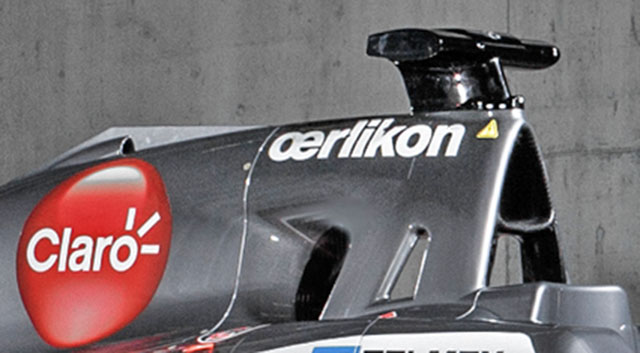
The roll hoop of the C33 is a continuation of the designs used on other recent Saubers, with four supporting legs. Note though the small additional cooling inlet on the engine cover. As is the case with the Ferrari the Sauber seems to have less cooling than other designs.
TEST 01: JEREZ, SPAIN
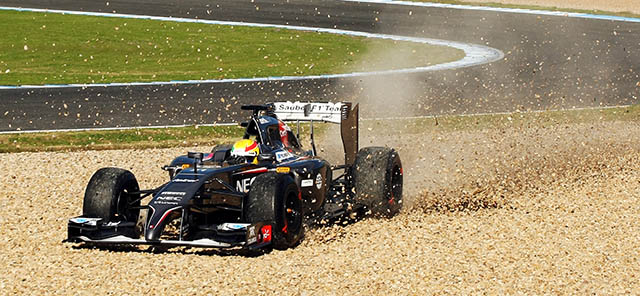
A look at the shape of the splitter on the Sauber, you can just see the curved leading edge of the monocoque at the rear (below).
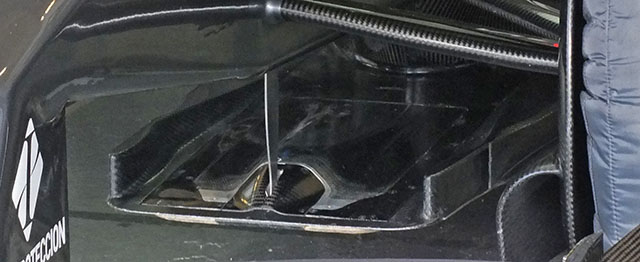
At Jerez an early testing off (top) lead to the team continuing the test with clearly damaged bodywork pockmarked with gravel impacts. The turning vane present at the cars photo shoot was missing at Jerez but the support is clear to see (it likely forms part of the upper side impact structure). Note the sidepod duct shape and the two smaller cooling ducts within it, these will likely be cooling internal components like the energy store.
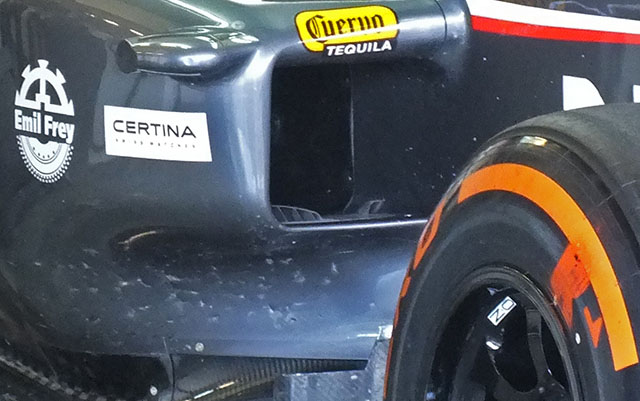
A tiny hole is present at the front of the chassis on the Sauber, its purpose is unclear, if it is for cooling the only components in this region are the dampers which are mounted higher in the chassis.
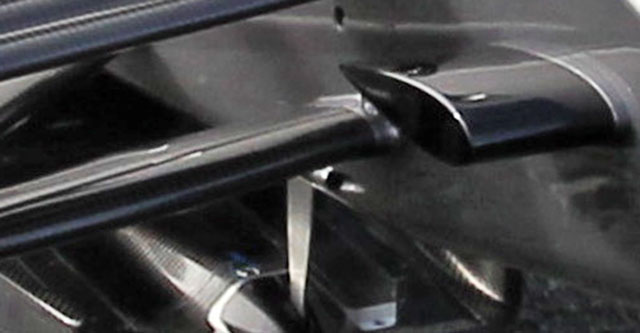
It could also be for driver cooling as the C33 does not have an obvious driver cooling duct on the nose.
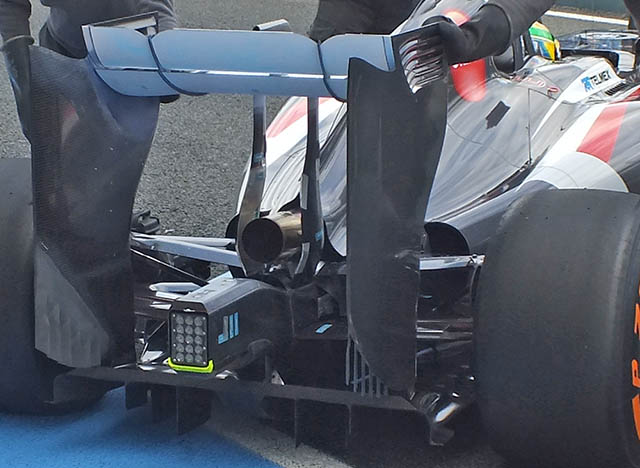
A good look at the rear end of the C33, note the very basic flat shape of the rear wing endplates and the seemingly hastily added serrations at the rear.
TEST 02: SAKHIR, BAHRAIN
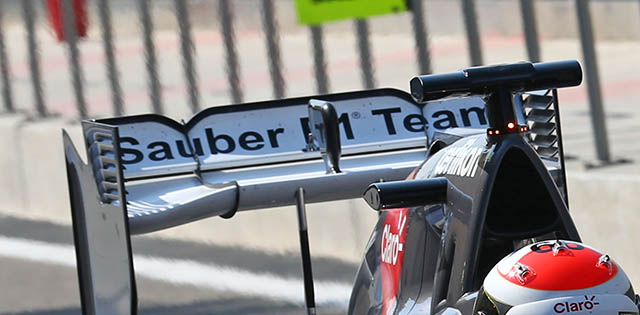
Sauber tried out two different rear wings at the second test, the first wing was the same as it ran in Jerez, with dopping outer portions of the main plane and twin notches in the upper element (above), the new version has a straight main plane and a single central notch in the upper element (below)
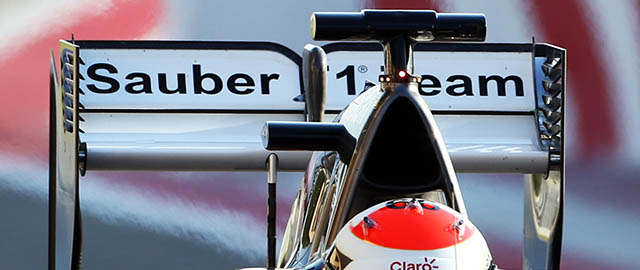
The pod wings missing at Jerez were fitted in Bahrain (below) and are clearly an evolution od the designs used in 2013 and 2012.
